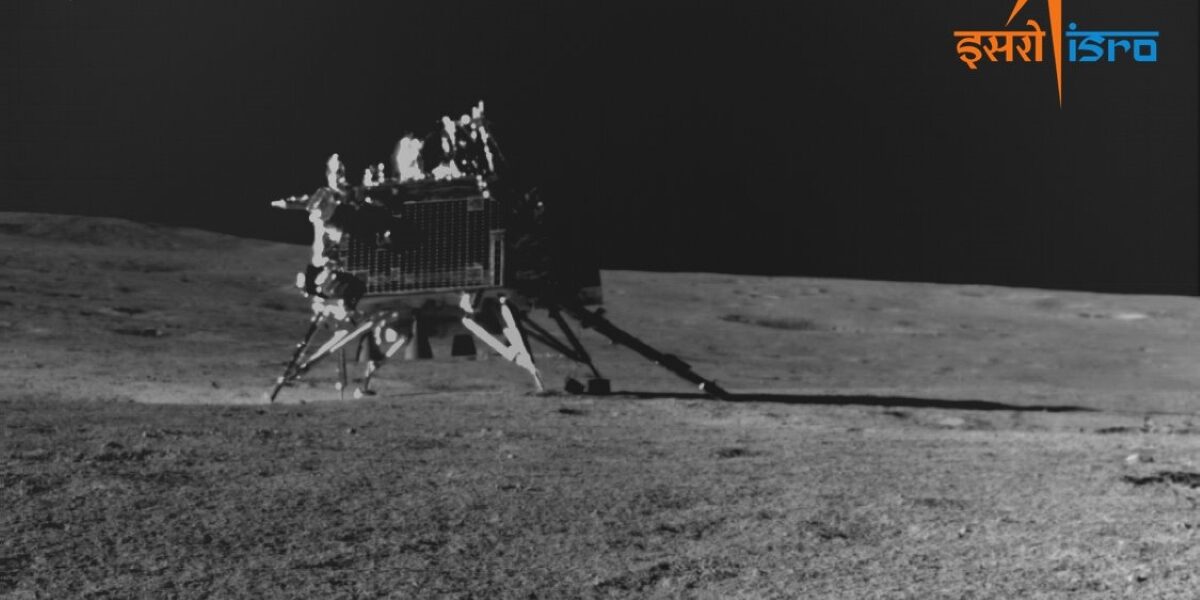ISRO investigates 'natural' event recorded by Chandrayaan-3 lander payload
Published Sep 01, 2023 | 2:06 PM ⚊ Updated Sep 01, 2023 | 2:06 PM

Chandrayaan 3 lander Vikram. (ISRO/X)
The preliminary analysis of the RAMBHA-LP payload’s data of the near-surface lunar plasma environment over the south pole region shows that the plasma there is comparatively sparse, the Indian Space Research Organisation (ISRO) reported on Thursday, 31 August.
“Radio Anatomy of Moon Bound Hypersensitive Ionosphere and Atmosphere – Langmuir Probe (RAMBHA-LP) payload onboard Chandrayaan-3 Lander has made first-ever measurements of the near-surface lunar plasma environment over the south polar region. The initial assessment indicates that the plasma near the lunar surface is relatively sparse,” ISRO said in a social media post.
These quantitative measurements potentially assist in mitigating the noise that Lunar plasma introduces into radio wave communication. Also, they could contribute to the enhanced designs for upcoming lunar visitors, ISRO said.
Chandrayaan-3 Mission:
In-situ Scientific ExperimentsRadio Anatomy of Moon Bound Hypersensitive Ionosphere and Atmosphere – Langmuir Probe (RAMBHA-LP) payload onboard Chandrayaan-3 Lander has made first-ever measurements of the near-surface Lunar plasma environment over the… pic.twitter.com/n8ifIEr83h
— ISRO (@isro) August 31, 2023
Meanwhile, the ILSA payload on the Chandrayaan-3 Lander to study lunar seismic activity has not only recorded the movements of the rover and other payloads but also has recorded an event, appearing to be a natural one, on 26 August.
“The source of this event is under investigation,” ISRO said.
ISRO also released a video of the Chandrayaan-3 rover rotating in search of a safe route. The rotation was captured by a Lander Imager Camera.
“It feels as though a child is playfully frolicking in the yards of Chandamama, while the mother watches affectionately. Isn’t it?”, the ISRO social media post read.
Chandrayaan-3 Mission:
The rover was rotated in search of a safe route. The rotation was captured by a Lander Imager Camera.It feels as though a child is playfully frolicking in the yards of Chandamama, while the mother watches affectionately.
Isn’t it?🙂 pic.twitter.com/w5FwFZzDMp— ISRO (@isro) August 31, 2023
Another instrument onboard the rover “Pragyan” has confirmed the presence of Sulphur (S) in the Lunar region, through a different technique, ISRO said.
The Alpha Particle X-ray Spectroscope (APXS) has detected S, as well as other minor elements.
“This finding by Ch-3 compels scientists to develop fresh explanations for the source of Sulphur (S) in the area: intrinsic?, volcanic?, meteoritic?….?”, read the post.
ISRO released a video showing an automated hinge mechanism rotating the 18 cm tall APXS, aligning the detector head to be approximately 5 cm in proximity to the lunar surface.
What are lunar soil and rocks made of in the south-polar region where Chandrayaan-3 landed? How’s it different from other highland regions? These are the questions that the 26-kg, six-wheeled, solar-powered rover is trying to answer with its scientific instruments.
APXS instrument is best suited for in-situ analysis of the elemental composition of soil and rocks on the surface of planetary bodies having little atmosphere, such as the Moon, an ISRO statement said.
It carries radioactive sources that emit alpha particles and x-rays onto the surface sample. The atoms present in the sample in turn emit characteristic X-ray lines corresponding to the elements present.
By measuring the energies and intensities of these characteristic x-rays, researchers can find the elements present and their abundances.
APXS observations have discovered the presence of interesting minor elements, including Sulfur, apart from the major expected elements such as Aluminum, Silicon, Calcium and Iron.
The Laser-Induced Breakdown Spectroscope (LIBS) instrument onboard the rover has already confirmed the presence of Sulphur. Detailed scientific analysis of these observations is in progress.
India on 23 August scripted history as ISRO’s ambitious third Moon mission Chandrayaan-3’s Lander Module (LM) touched down on the lunar surface, making it only the fourth country to accomplish the feat, and the first to reach the uncharted south pole of Earth’s only natural satellite.
Prime Minister Narendra Modi on 26 August announced the decision to name the spot where the Chandrayaan-3 Vikram Lander made a soft landing as “Shiv Shakti Point” and the site where the Chandrayaan-2 lander crash-landed on the Moon’s surface in 2019 as “Tiranga Point”.
Also, 23 August, the day the Chandrayaan-3 Lander touched down on the lunar surface, would be celebrated as National Space Day’, Modi said.
This achievement made India the fourth country in the world — following the erstwhile Soviet Union, the US, and China — to successfully achieve a gentle landing on the Moon.
(With PTI inputs)
